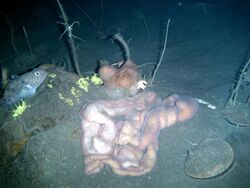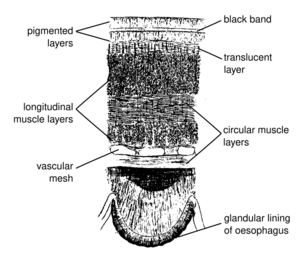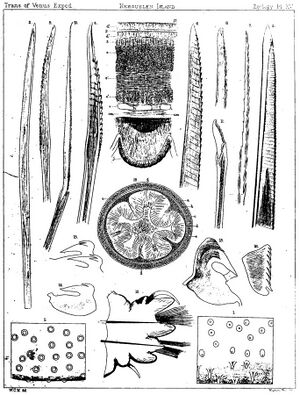Biology:Parborlasia corrugatus
| Parborlasia corrugatus | |
|---|---|

| |
| Parborlasia corrugatus from the Ross Sea | |
| Scientific classification | |
| Kingdom: | |
| Phylum: | |
| Class: | |
| Order: | |
| Family: | Cerebratulidae
|
| Genus: | Parborlasia
|
| Species: | P. corrugatus
|
| Binomial name | |
| Parborlasia corrugatus (McIntosh, 1876)
| |
| Synonyms | |
|
Cerebratulus charcoti | |
Parborlasia corrugatus is a proboscis worm in the family Cerebratulidae.[1] This species of proboscis or ribbon worm can grow to 2 metres (6 ft 7 in) in length, and lives in marine environments down to 3,590 metres (11,780 ft). This scavenger and predator is widely distributed in cold southern oceans.
Description
Parborlasia corrugatus is smooth and flat. Adults measure 1–2 metres (3 ft 3 in–6 ft 7 in), with a diameter of approximately 2 cm (0.79 in). Specimens can weigh up to 140 grams (4.9 oz). Their colouration is variable, ranging from cream through various tones of black.[2][3] This worm has a wedge-shaped head containing a cavity filled with fluid. It uses this to fire an adhesive, barbed proboscis as a means of defense, and to capture prey.[2] This organ has adhesive secretion to aid in securing its meal.
Although this creature does not have a dedicated respiratory system, Parborlasia corrugatus is able to obtain oxygen by absorbing it through its skin. An animal of its size would typically find it difficult to receive enough oxygen this way, but this worm has a low metabolic rate, and also enjoys the advantage of its environment, which is cold, oxygen-rich Antarctic waters. When Parborlasia corrugatus experiences lower levels of oxygen in the water, it flattens and elongates its body to aid in the uptake of oxygen by increasing its skin area. This manoevre also reduces the distance that the oxygen must travel to diffuse into its body.[2]
Potential predators avoid this species as it has a chemical defense: acidic mucus with a pH 3.5.[2]
Distribution
This species is found from the intertidal zone to depths of up to 3,590 metres (11,780 ft). It is found throughout the following areas:[2]
- Antarctica
- Antarctic Peninsula
- south Atlantic Ocean[4]
- South Shetland Islands ( [ ⚑ ] 62°00′S 58°00′W / 62°S 58°W)
- South Orkney Islands ( [ ⚑ ] 60°35′S 45°30′W / 60.583°S 45.5°W)
- South Sandwich Islands ( [ ⚑ ] 57°45′S 26°30′W / 57.75°S 26.5°W)
- South Georgia Island ( [ ⚑ ] 54°15′S 36°45′W / 54.25°S 36.75°W)
- Bouvet Island ( [ ⚑ ] 54°26′S 03°24′E / 54.433°S 3.4°E)
- Kerguelen Island ( [ ⚑ ] 49°15′S 69°35′E / 49.25°S 69.583°E)
- Cargados Carajos Shoals in the Indian Ocean
- Falkland Islands
- Tierra del Fuego ( [ ⚑ ] 54°00′S 70°00′W / 54°S 70°W)
- southern Argentina
- Peru
- Chile
Densities range greatly from 0.3 m−2 recorded in McMurdo Sound, to the substantially higher densitiy of 26.2 m−2 around Signy Island.[3]
Reproduction
This dioecious species broadcast spawns. The resulting pilidium larvae survive in the water column for up to 150 days.[3]
Diet
Parborlasia corrugatus is both a scavenger and a predator, and feeds upon detritus diatoms, gastropods, amphipods, isopods, various vertebrate carrion, sponges (including Homaxinella balfourensis), jellyfish, seastars, molluscs, anemones, and polychaete worms.[2][3]
References
- ↑ Giant Antarctic Marine Worm – Parbolasia Corrugatus : Zooillogix
- ↑ 2.0 2.1 2.2 2.3 2.4 2.5 Peter Brueggeman. Nemertina, proboscis worms – Underwater Field Guide to Ross Island & McMurdo Sound, Antarctica
- ↑ 3.0 3.1 3.2 3.3 Daniel J. Thornhill; Andrew R. Mahon; Jon L. Norenburg; Kenneth M. Halanych (2008). "Open-ocean barriers to dispersal: a test case with the Antarctic Polar Front and the ribbon worm Parborlasia corrugatus (Nemertea: Lineidae)". Molecular Ecology 17: 5104–5117. doi:10.1111/j.1365-294X.2008.03970.x. PMID 18992005. https://www.bowdoin.edu/faculty/d/dthornhi/pdf/Thornhilletal2008ME.pdf/.
- ↑ Antarctic Invertebrates: Parborlasia fueguina
Further reading
- Clarke, A.; Johnston, N.M. (2003). Antarctic marine benthic diversity. Oceanogr. Mar. Biol. Annu. Rev. 41: 47–114
- Biology of the Antarctic Seas XIV, Antarctic Research Series 39(4):289–316, 1983
- Science 245:1484–1486, 1989
- Ecological Monographs 44(1):105–128, 1974
- Journal of Experimental Marine Biology and Ecology 153(1):15–25, 1991
- Antarctic Science 10(4):369–375, 1998
- Polar Biology 25(3):238–240, 2002
- Polar Biology 29(2):106–113, 2006
- Clarke A, Prothero-Thomas E (1997) The influence of feeding on oxygen consumption and nitrogen excretion in the Antarctic nemertean Parborlasia corrugatus. Physiological Zoology, 70, 639–649.
- Gibson R (1983) Antarctic nemerteans: the anatomy, distribution, and biology of Parborlasia corrugatus (McIntosh, 1876) (Heter-onemertea, Lineidae). Biology of the Antarctic seas. XIV. Antarctic Research Series, 39, 289–316.
- Heine JN, McClintock JB, Slattery M, Weston J (1991) Energetic composition, biomass, and chemical defense in the common Antarctic nemertean Parborlasia corrugatus McIntosh. Journal of Experimental Marine Biology and Ecology, 153, 15–25.
- Peck LS (1993) Larval development in the Antarctic nemertean Parbolasia corrugatus (Heteronemertea, Lineidae). Marine Biology, 116, 301–310.
- Rogers AD, Clarke A, Peck LS (1998) Population genetics of the Antarctic heteronemertean Parbolasia corrugatus from the South Orkney Islands. Marine Biology, 131, 1–13.
External links
Wikidata ☰ Q2436196 entry



